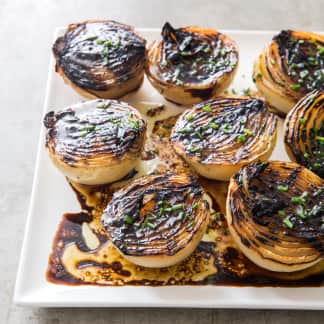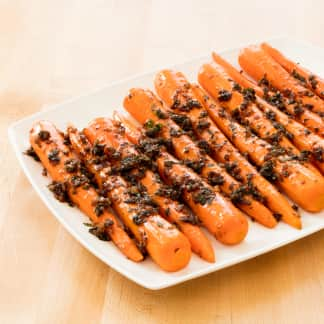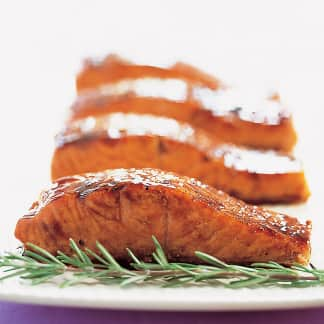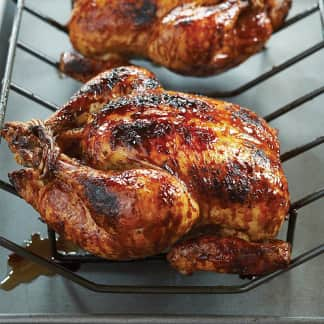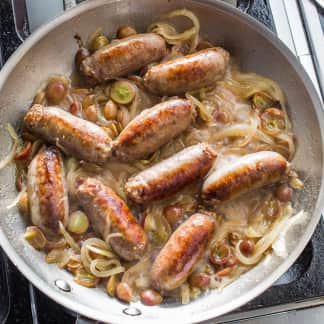Reviews You Can Trust.
See Why.
Supermarket Balsamic Vinegar
In recent years, Italy has created a new set of guidelines for mass-produced balsamic vinegar. We wanted to know if these new laws guarantee a better-quality product.
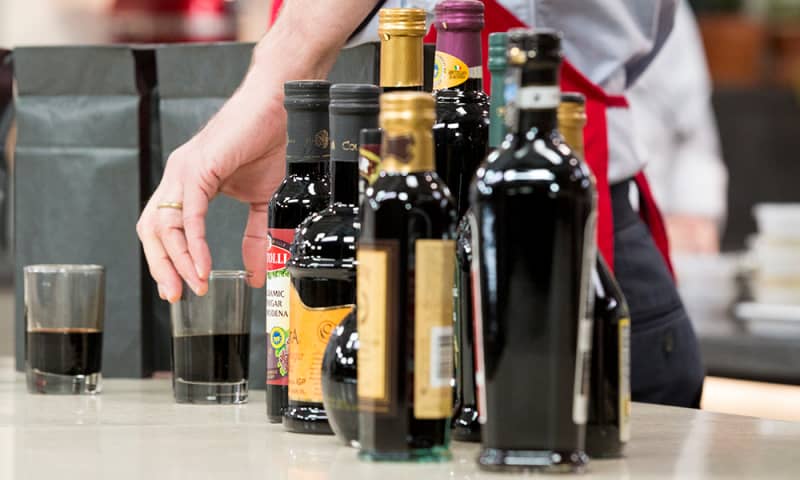
Top Pick

WinnerBertolli Balsamic Vinegar of Modena
Served plain, this balsamic vinegar tasted of dried fruit like figs, raisins, and prunes. Some of these nuances disappeared once it was reduced or whisked into vinaigrette, but it still tasted pleasantly sweet. While its texture was fairly thin, its flavor earned high marks in the dressing and the glaze.
Ingredients: Wine vinegar, concentrated grape must, cooked grape must, caramel color, antioxidant: sulphites
Price at Time of Testing: $3.49 for 8.5 fl oz ($0.41 per fl oz)
Served plain, this balsamic vinegar tasted of dried fruit like figs, raisins, and prunes. Some of these nuances disappeared once it was reduced or whisked into vinaigrette, but it still tasted pleasantly sweet. While its texture was fairly thin, its flavor earned high marks in the dressing and the glaze.
Ingredients: Wine vinegar, concentrated grape must, cooked grape must, caramel color, antioxidant: sulphites
Price at Time of Testing: $3.49 for 8.5 fl oz ($0.41 per fl oz)
Sign up for the Well-Equipped Cook newsletter
Shop smarter with our ATK Reviews team's expert guides and recommendations.
What You Need to Know
The first thing to understand when you set out to buy balsamic vinegar at the grocery store is that it has little to do with the traditionally made, name-protected Italian artisanal product called aceto balsamico tradizionale. It’s not even made for the same purpose. The traditional stuff is a small-batch, long-aged product that bears a Denominazione di Origine Protetta (DOP) seal indicating use of locally grown ingredients and adherence to strict guidelines. Costing as much as $250 for a tiny 3.4-ounce bottle, it’s meant to be drizzled sparingly over steak or strawberries—or even sipped. Masking its flavors in vinaigrette or burning them off in a cooked application would be a tragic mistake.
That’s where the supermarket stuff comes in. This inexpensive mass-produced product is designed for salad dressing or to make a sweet-tart reduction to drizzle over vegetables or grilled meats. While its flavor isn’t anywhere near as complex as traditional balsamic, it can still have a pleasing fruity bite, which makes it a staple in most American kitchens.
Since we last tasted supermarket balsamic vinegar in 2007, a new certification process for this product has been put in place. Vinegars that are produced in either Reggio Emilia or Modena (the only two provinces where traditional balsamic can be made) and follow certain other guidelines can call themselves “balsamic vinegar of Modena” and bear an Indicazione Geografica Protetta, or IGP, seal on their labels. Curious if this certification process would raise the standards and give us a better supermarket option at the same affordable price, we rounded up nine widely available balsamic vinegars of Modena with an IGP seal (including our former winner), all sold for no more than $15 a bottle, and conducted a series of blind taste tests. We sampled them plain, whisked into vinaigrette, and reduced to make a quick glaze that we served over asparagus.
Label Laws
Straight from the bottles, the vinegars ranged from nearly as thick as traditional balsamic to as watery and thin as distilled white vinegar. The plain tasting revealed a similarly wide array of flavors. The best versions tasted of caramelized sugar or roasted fruit and had a smooth, pleasant tang; others had a fake, candy-like sweetness or, at the opposite end of the spectrum, tasted harshly acidic. We were puzzled. How could all these products qualify under the exact same standards?
We did a little investigating and discovered that the guidelines governing the use of the seal are pretty loose. IGP laws do outline a list of approved ingredients—namely, that the vinegar begin with the must (the skin, seeds, and juice) from select native Italian grape varietals. But they require that only 20 percent of the finished product consist of grape must (compared with the 100 percent required for traditional balsamic). So what makes up the remaining 80 percent? Regular wine vinegar made anywhere. Second, although some aging is mandatory, 60 days are all that’s required—a far cry from traditional vinegar’s 12-year minimum. And finally, while production must take place within Reggio Emilia or Modena and certain varieties of grapes are required, the grapes can be grown anywhere in the world.
But here’s the kicker: Unlike batches of traditional balsamic vinegar, which are subjected to a final taste test so rigorous that roughly 20 percent of submissions fail it, nearly every vat of vinegar that follows the loose IGP rules for production becomes certified, explaining the wide range we’d observed in our tastings.
Ferreting Out a Winner
We now knew why vinegars bearing the IGP seal could taste so different. And yet we couldn’t find a trend in our plain tasting results that connected our preferences to any particular manufacturing methods. Some products use more of the native grape must than others and/or cook the must in open vats as do traditional balsamic makers (cooking in vats allows for caramelization and, thus, more complex flavor development than what is produced by mechanical processing)—but neither of these variables was necessarily linked to the vinegars we preferred. Seven of the nine manufacturers confirmed that they age their balsamics for the minimum time. Of the two remaining, one cited the vague range of “60 days to two years,” and the other, our former winner, qualified as what is known as invecchiato, meaning that it is aged for more than three years. Our front-runner ages for the minimum time.
But we still had the reduction and vinaigrette tastings to go, and interestingly, after these two tastings the playing field leveled off just a bit. Six of the products we tried were perfectly acceptable once incorporated into a vinaigrette or reduced and drizzled over asparagus. The additional ingredients in the dressing softened any sharp acidity, while reducing these vinegars added body to thinner products but didn’t adversely affect the thickest. Our objections to the other three vinegars in the lineup only mellowed enough to recommend them with reservations. Though they’d do in a pinch, they retained the artificial sweetness or harshness tasters had objected to in the plain tasting.
While each of our top six balanced fruity sweetness with bright acidity, one came out on top. Our winner has a “lush,” “syrupy” texture in vinaigrette and an “almost drinkable” flavor with notes of apple, molasses, and dried fruit. Best of all, at only $3.49 for an 8.5-ounce bottle ($0.41 per fluid ounce), it’s affordable enough to use every day.
The In-Between Balsamic
Inexpensive supermarket balsamic is best for everyday use, while costly traditional vinegar should be reserved for drizzling on berries, steaks, or a good cheese. But there’s another category of balsamic vinegar, sold in specialty shops and some supermarkets, that falls between the two. Many of these vinegars hold themselves to a higher standard, including adding less wine vinegar and aging longer. We bought three bottles of these midrange balsamics (La Vecchia Dispensa Organic Condiment, San Giacomo Essenza Riserve Balsamic, and Oliviers & Co. Velluto Balsamic Condiment), priced between $4 and $10 per ounce, recommended by a local gourmet shop. We tried them plain, drizzled on berries, and in vinaigrette.
Straight out of the bottle we noticed that they had a syrupy consistency closer to that of traditional vinegar, and when we drizzled them over berries, tasters actually deemed their consistency, honeyed sweetness, and fruity complexity a surprisingly close approximation of 25-year-aged tradizionale, though the nuances of each vinegar varied a bit. But also like a traditional balsamic, these midrange vinegars were ill-suited to vinaigrette—the dressings made with them were all sticky and gloppy, more like a tart caramel sauce than a salad dressing. This is because like the traditional balsamics, these vinegars have more of what are known as polymeric pigments, which form gel-like droplets with oil, than supermarket vinegars. Our recommendation? For use as an everyday ingredient in dressings and cooking, opt for balsamic vinegar of Modena from the supermarket. But if you want a vinegar that can affordably do the job of the pricey traditional vinegar, these midprice balsamics are a great option. Because the flavor and consistency can vary from brand to brand, ask for recommendations at your local gourmet shop.
America's Test KitchenWatch Now
Everything We Tested
Recommended

WinnerBertolli Balsamic Vinegar of Modena
Served plain, this balsamic vinegar tasted of dried fruit like figs, raisins, and prunes. Some of these nuances disappeared once it was reduced or whisked into vinaigrette, but it still tasted pleasantly sweet. While its texture was fairly thin, its flavor earned high marks in the dressing and the glaze.
Ingredients: Wine vinegar, concentrated grape must, cooked grape must, caramel color, antioxidant: sulphites
Price at Time of Testing: $3.49 for 8.5 fl oz ($0.41 per fl oz)
Served plain, this balsamic vinegar tasted of dried fruit like figs, raisins, and prunes. Some of these nuances disappeared once it was reduced or whisked into vinaigrette, but it still tasted pleasantly sweet. While its texture was fairly thin, its flavor earned high marks in the dressing and the glaze.
Ingredients: Wine vinegar, concentrated grape must, cooked grape must, caramel color, antioxidant: sulphites
Price at Time of Testing: $3.49 for 8.5 fl oz ($0.41 per fl oz)
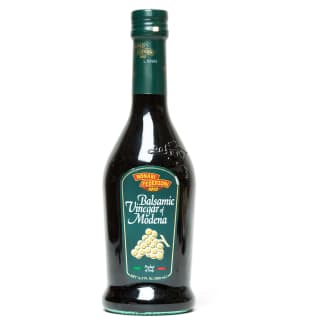
Monari Federzoni Balsamic Vinegar of Modena
Tasters praised the consistency of this vinegar, which was viscous but not too thick to coat greens or asparagus. It had a bright acidity and “nice fruit flavor” that made for a sweet glaze and boasted hints of blueberries and wine when served plain.
Ingredients: Wine vinegar, concentrated grape must, caramel color, contains sulfites
Price at Time of Testing: $2.50 for 16.9 fl oz ($0.15 per fl oz)
Tasters praised the consistency of this vinegar, which was viscous but not too thick to coat greens or asparagus. It had a bright acidity and “nice fruit flavor” that made for a sweet glaze and boasted hints of blueberries and wine when served plain.
Ingredients: Wine vinegar, concentrated grape must, caramel color, contains sulfites
Price at Time of Testing: $2.50 for 16.9 fl oz ($0.15 per fl oz)

Colavita Balsamic Vinegar of Modena
Although some tasters noted harshness in this vinegar when sampling it plain, this was tempered to a “nice bite” in vinaigrette and glaze. In those applications, a fruity sweetness came to the forefront. As one taster said, “It’s perfectly balanced.”
Ingredients: Wine vinegar, concentrated grape must, caramel color, contains sulfites
Price at Time of Testing: $2.99 for 17 fl oz ($0.18 per fl oz)
Although some tasters noted harshness in this vinegar when sampling it plain, this was tempered to a “nice bite” in vinaigrette and glaze. In those applications, a fruity sweetness came to the forefront. As one taster said, “It’s perfectly balanced.”
Ingredients: Wine vinegar, concentrated grape must, caramel color, contains sulfites
Price at Time of Testing: $2.99 for 17 fl oz ($0.18 per fl oz)
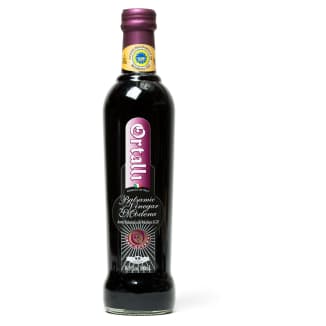
Ortalli Balsamic Vinegar of Modena
Tasters approved of the full and “balanced” flavors of this balsamic. Plain, it tasted of cooked fruit; in vinaigrette and glaze, it showcased flavors of plum, honey, and molasses. Although it was a little thin in body even when reduced, its rich flavor and pleasant acidity more than made up for it.
Ingredients: Wine vinegar, cooked grape must, caramel color, contains sulfites
Price at Time of Testing: $6.69 for 16.9 fl oz ($0.40 per fl oz)
Tasters approved of the full and “balanced” flavors of this balsamic. Plain, it tasted of cooked fruit; in vinaigrette and glaze, it showcased flavors of plum, honey, and molasses. Although it was a little thin in body even when reduced, its rich flavor and pleasant acidity more than made up for it.
Ingredients: Wine vinegar, cooked grape must, caramel color, contains sulfites
Price at Time of Testing: $6.69 for 16.9 fl oz ($0.40 per fl oz)
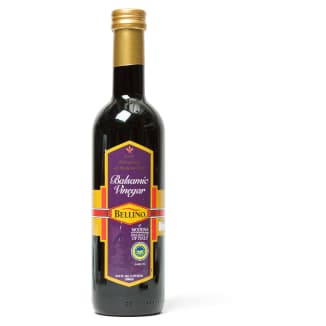
Bellino Balsamic Vinegar of Modena
This vinegar consistently scored in the middle of the lineup. Although it was both sweet and acidic, it lacked complexity and was deemed “not outstanding,” even a bit “boring.” It showed to its best advantage in the vinaigrette, where its sweet start and pleasantly bright finish made it a crowd-pleaser.
Ingredients: Wine vinegar, concentrated grape must, caramel color, contains sulfites
Price at Time of Testing: $5.49 for 16.9 fl oz ($0.32 per fl oz)
This vinegar consistently scored in the middle of the lineup. Although it was both sweet and acidic, it lacked complexity and was deemed “not outstanding,” even a bit “boring.” It showed to its best advantage in the vinaigrette, where its sweet start and pleasantly bright finish made it a crowd-pleaser.
Ingredients: Wine vinegar, concentrated grape must, caramel color, contains sulfites
Price at Time of Testing: $5.49 for 16.9 fl oz ($0.32 per fl oz)

Lucini Aged Balsamic Vinegar of Modena
The only aged product in our lineup, this vinegar was so viscous and thick when tasted plain that tasters compared it with port and dessert wine. Whisked in vinaigrette and reduced to a glaze, it became sticky and syrupy—appealing to some tasters, but overwhelming to others. Although the label does not list the ingredients, the company confirmed that it uses a mix of grape must and wine vinegar.
Ingredients: Contains sulfites from grapes
Price at Time of Testing: $13.99 for 8.5 fl oz ($1.65 per fl oz)
The only aged product in our lineup, this vinegar was so viscous and thick when tasted plain that tasters compared it with port and dessert wine. Whisked in vinaigrette and reduced to a glaze, it became sticky and syrupy—appealing to some tasters, but overwhelming to others. Although the label does not list the ingredients, the company confirmed that it uses a mix of grape must and wine vinegar.
Ingredients: Contains sulfites from grapes
Price at Time of Testing: $13.99 for 8.5 fl oz ($1.65 per fl oz)
Recommended with reservations
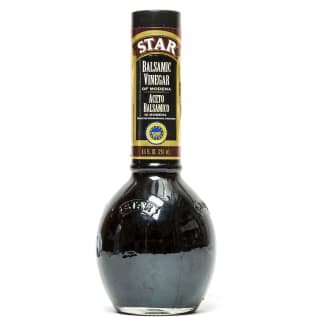
Star Balsamic Vinegar of Modena
Though this vinegar earned some favorable reviews, we still have reservations. Namely: It was too sharp and “puckery” when tasted plain and maintained its harshness even when reduced to a glaze. What we did like: a consistency that was pleasantly thick in vinaigrette and became “syrupy” when reduced.
Ingredients: Wine vinegar, concentrated grape must, boiled grape must, caramel color, potassium metabisulfite as a preservative
Price at Time of Testing: $2.99 for 8.5 fl oz ($0.35 per fl oz)
Though this vinegar earned some favorable reviews, we still have reservations. Namely: It was too sharp and “puckery” when tasted plain and maintained its harshness even when reduced to a glaze. What we did like: a consistency that was pleasantly thick in vinaigrette and became “syrupy” when reduced.
Ingredients: Wine vinegar, concentrated grape must, boiled grape must, caramel color, potassium metabisulfite as a preservative
Price at Time of Testing: $2.99 for 8.5 fl oz ($0.35 per fl oz)

Cento Balsamic Vinegar of Modena
At our plain tasting, the berry notes of this vinegar drew comparisons to candy, juice, and even Kool-Aid. Similar comments came up during the vinaigrette tasting: “like jelly candy.” It was also panned for being harsh and “astringent,” with “an assertive and unpleasant bite, like alcohol.” It mellowed to an acceptable level of fruitiness when reduced to a glaze. As for the consistency, it scored in the middle of the pack straight from the bottle and became “nice and thick” when reduced or whisked in vinaigrette.
Ingredients: Wine vinegar, concentrated grape must, caramel E 150d, antioxidant: (sulfites) E 224
Price at Time of Testing: $3.49 for 16.9 fl oz ($0.21 per fl oz)
At our plain tasting, the berry notes of this vinegar drew comparisons to candy, juice, and even Kool-Aid. Similar comments came up during the vinaigrette tasting: “like jelly candy.” It was also panned for being harsh and “astringent,” with “an assertive and unpleasant bite, like alcohol.” It mellowed to an acceptable level of fruitiness when reduced to a glaze. As for the consistency, it scored in the middle of the pack straight from the bottle and became “nice and thick” when reduced or whisked in vinaigrette.
Ingredients: Wine vinegar, concentrated grape must, caramel E 150d, antioxidant: (sulfites) E 224
Price at Time of Testing: $3.49 for 16.9 fl oz ($0.21 per fl oz)
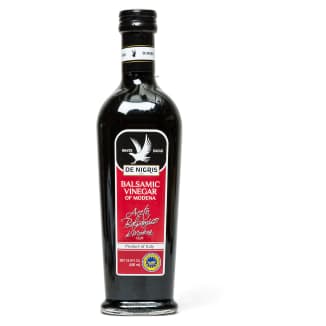
De Nigris Balsamic Vinegar of Modena, White Eagle
This sample consistently fell to the bottom of our rankings. Although it lent acidic brightness to vinaigrette and glaze, it had a one-note flavor that bordered on “tannic,” and some tasters noticed a “harsh” aftertaste. It remained thin and mild-tasting even when reduced.
Ingredients: Wine vinegar, concentrated grape must, caramel, contains sulfites
Price at Time of Testing: $5.49 for 16.9 fl oz ($0.32 per fl oz)
This sample consistently fell to the bottom of our rankings. Although it lent acidic brightness to vinaigrette and glaze, it had a one-note flavor that bordered on “tannic,” and some tasters noticed a “harsh” aftertaste. It remained thin and mild-tasting even when reduced.
Ingredients: Wine vinegar, concentrated grape must, caramel, contains sulfites
Price at Time of Testing: $5.49 for 16.9 fl oz ($0.32 per fl oz)
*All products reviewed by America’s Test Kitchen are independently chosen, researched, and reviewed by our editors. We buy products for testing at retail locations and do not accept unsolicited samples for testing. We list suggested sources for recommended products as a convenience to our readers but do not endorse specific retailers. When you choose to purchase our editorial recommendations from the links we provide, we may earn an affiliate commission. Prices are subject to change.
Reviews You Can Trust
The mission of America’s Test Kitchen Reviews is to find the best equipment and ingredients for the home cook through rigorous, hands-on testing. Have a question or suggestion? Send us an email at atkreviews@americastestkitchen.com. We appreciate your feedback!
Reviews You Can Trust.
See Why.

